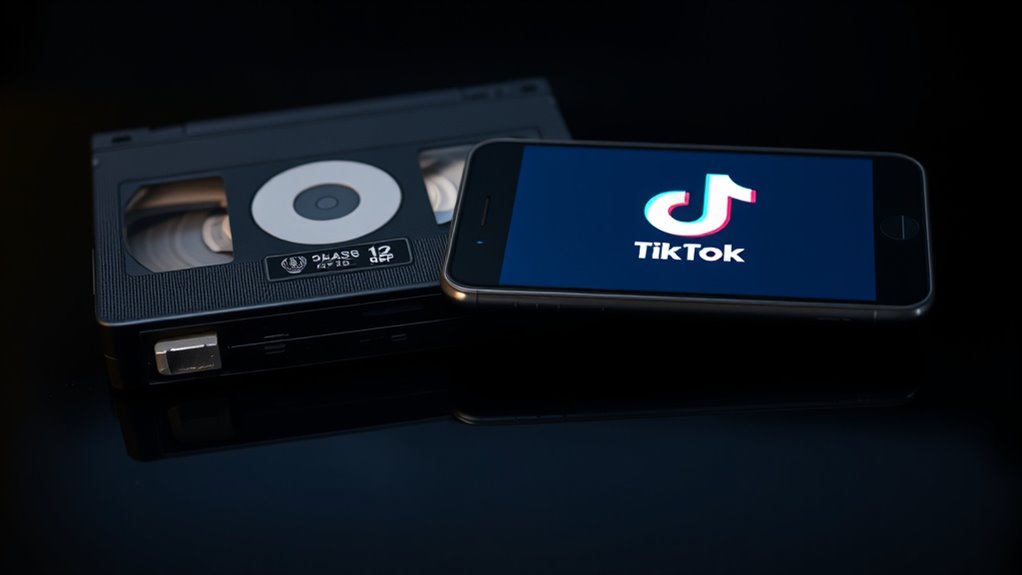The idea that technology has shrunk your attention span isn’t true; instead, digital overload drains your mental resources, causing fatigue and burnout. Your capacity to focus remains strong, but constant notifications and scrolling tire your brain. Throughout history, longer media like VHS tapes didn’t reduce attention spans—they offered immersive experiences. Modern short videos adapt to your focus limits, not diminish your ability to concentrate. Keep exploring, and you’ll discover how managing digital overload helps preserve your attention.
Key Takeaways
- Historical media like VHS involved longer viewing sessions, with no evidence of shrinking attention spans over time.
- Digital overload causes mental fatigue, not a decline in the brain’s capacity to focus.
- Short-form platforms like TikTok adapt to current attention “windows,” reflecting environmental demands, not reduced focus.
- Attention is flexible; managing digital chaos with breaks and mindfulness helps maintain sustained focus.
- Human attention remains resilient; fluctuations depend on motivation and environment, not media format changes.

Many people assume that digital media has shortened our attention spans, but history suggests otherwise. Instead of a decline, what we’re experiencing is often digital overload, which leads to cognitive fatigue. When you’re constantly bombarded with notifications, videos, and scrolling, it’s easy to feel drained and distracted. This doesn’t mean your attention span is shrinking; it indicates that your brain is overwhelmed. Over time, this overload can cause burnout, making it harder to focus on any single task. But the core ability to pay attention remains intact; it’s just that your mental resources are taxed.
Think about how earlier generations consumed media. When VHS tapes were popular, people would often watch a single movie in one sitting, sometimes for hours. It wasn’t that attention spans shrank; it’s that the media environment was different. There were fewer distractions, and viewers could immerse themselves in longer content without interruption. Today, digital platforms like TikTok thrive on short-form videos precisely because they cater to our limited attention windows. But this doesn’t mean we’ve lost the ability to focus; it shows how our attention is adaptable, responding to the environment we’re in.
Your brain is incredibly resilient. When you experience cognitive fatigue from digital overload, it’s your signal to pause and reset. Instead of blaming your attention span, recognize that your brain needs time to recover. Regular breaks from screens, mindfulness, and limiting notifications can help restore your mental clarity. These strategies aren’t about fighting a shrinking attention span; they’re about managing your cognitive load. When you reduce digital overload, you give your mind space to focus deeply again; this is supported by understanding how media consumption habits influence cognitive functioning. Whether it’s reading a book, solving a problem, or engaging in meaningful conversation, you can rebuild your focus.
What’s more, studies show that humans are capable of sustained attention for longer periods than many believe. Our attention span isn’t static—it fluctuates based on interest, motivation, and environment. The myth of the shrinking attention span overlooks how adaptable and resilient your cognition truly is. It’s not about losing the ability to concentrate; it’s about managing the digital chaos that can drain your mental energy. So, instead of feeling powerless or frustrated, focus on creating a balanced media intake. By doing so, you preserve your cognitive capacity, ensuring that when you want to engage deeply, your mind is ready. Your attention span isn’t dying—it’s just waiting for you to give it a healthier environment to thrive in.
Frequently Asked Questions
How Do Attention Spans Vary Across Different Age Groups?
You might notice that attention spans differ across age groups, especially due to digital multitasking and content fragmentation. Younger people often switch quickly between tasks, making their attention more adaptable but shorter for single tasks. Older adults tend to focus longer on one thing. These variations aren’t signs of a shrinking attention span but reflect how digital environments, with constant notifications and fragmented content, influence focus differently across ages.
What Role Does Technology Design Play in Attention Span Changes?
You might wonder how technology design influences attention spans. Neuroscience insights reveal that interface ergonomics, like quick feedback and engaging visuals, keep you hooked longer. Developers craft these features to maximize your engagement, often making it harder to focus on less stimulating tasks. So, it’s not just you—technology design actively shapes your attention span by leveraging how your brain responds to visual and interactive cues.
Are There Cultural Differences in Attention Span Perceptions?
Congratulations, you now get to be the expert on cultural attention span differences! You might assume everyone’s the same, but cultural norms shape perception biases—what’s considered focused in one society might seem distracted in another. So, don’t fall for the myth that attention spans are shrinking universally; instead, recognize that cultural context influences how we perceive and value attention, making it a fascinating, diverse phenomenon.
How Can Educators Adapt to Changing Attention Spans Effectively?
You can adapt to changing attention spans by incorporating mindfulness strategies into your teaching to help students focus better. Additionally, make your curriculum flexible, allowing for shorter activities and varied formats to keep engagement high. These approaches help students stay attentive, regardless of shifting attention spans, and create a more inclusive learning environment. Embrace these techniques to better meet your students’ needs in an evolving educational landscape.
What Are the Long-Term Cognitive Impacts of Digital Media Consumption?
Like Icarus flying too close to the sun, you might worry about digital media’s long-term effects. You could experience digital fatigue and struggle with information overload, which may impact your focus and memory over time. While some believe these impacts are irreversible, research suggests they’re manageable with balanced media use. Staying mindful helps protect your cognitive health, ensuring you benefit from digital innovations without suffering lasting harm.
Conclusion
So, next time you catch yourself scrolling, remember this myth isn’t a trap, but a shifting tide. Your attention isn’t shrinking; it’s just riding a different wave, adapting to new shores. Like a chameleon changing colors, your focus evolves with the times. Embrace this dance with technology, knowing your mind’s resilience keeps pace. The story isn’t about shrinking spans, but about your ability to navigate the vibrant, ever-changing landscape of attention.










